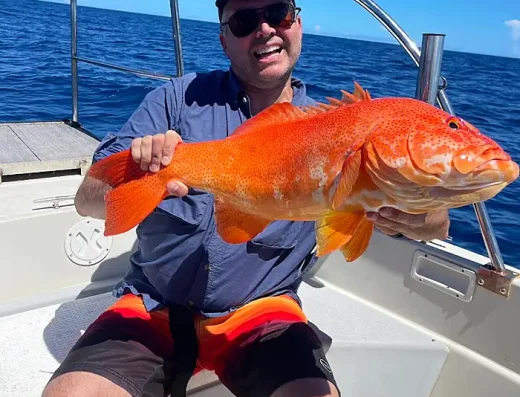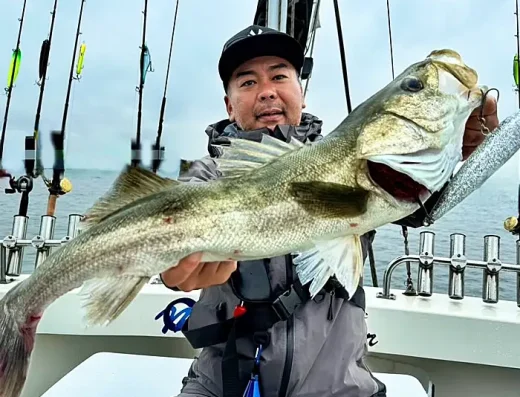Charter Fishing in Japan
Japan offers diverse fishing opportunities ranging from offshore bluewater to inshore coastal and freshwater rivers and lakes.
TrustedFish connects anglers with proven local captains in Japan —no commissions, no pay-to-play listings, no BS. Every charter on our platform is invite-only, vetted for skill, local knowledge, and reputation. If they’re listed, they’ve earned it.
Top Rated Charters in Japan
Japan Fishing Guide
Japan’s fisheries are shaped by its extensive coastline, island chains, and inland waters that host a remarkable variety of species. The Pacific side sees strong offshore currents where tuna, marlin, and dorado migrate, while the Sea of Japan coast is better known for bottom species and squid. Inland, the rivers and lakes are home to trout, salmon runs, and warmwater fish like bass and carp. Hokkaido provides cold-water fishing with salmon, char, and trout, while Okinawa and the southern islands are known for reef species, giant trevally, and seasonal pelagics.
Seasonal patterns are well defined: spring brings migratory baitfish and the predators that follow them, summer is peak offshore tuna and marlin time, fall sees strong inshore and freshwater bites, and winter favors bottom fishing and squid jigging. Each island group has its own rhythm, but the entire country experiences noticeable seasonal shifts.
Charter fishing in Japan is well developed, especially around major ports like Tokyo Bay, Osaka, Nagasaki, and Okinawa. Trips range from half-day coastal outings for seabass, flounder, or squid, to full-day and overnight bluewater runs targeting tuna and marlin. The fleet includes everything from small inshore boats and traditional Japanese skiffs to larger offshore vessels fitted for trolling heavy tackle.
Techniques vary widely but jigging, slow-pitch jigging, live bait, and trolling dominate offshore grounds. Inshore, anglers rely on casting lures for seabass and flounder, vertical jigging for yellowtail, and bait fishing for bottom species. Freshwater sees a mix of fly fishing, bait fishing, and lure casting, depending on the target. Fly anglers find trout and char in mountain streams, while spinning rods are common for bass and perch. Overall, Japan’s waters require a versatile approach, with anglers adapting to the season, region, and target species.
Fishing Seasons in Japan
Spring
As waters warm, baitfish schools appear along the coasts, bringing in yellowtail, seabass, and flounder. Offshore currents start to strengthen, setting the stage for the coming pelagic season, though tuna are still scattered. In the rivers, trout and char fishing improves with the snowmelt in Hokkaido and northern Honshu. Southern areas like Okinawa see reef action pick up, with trevally and grouper more active. Anglers rely on light jigging and lure casting in coastal waters, while fly fishing gains momentum inland.
Summer
This is peak offshore season, with bluefin and yellowfin tuna, marlin, and dorado running the Pacific side. Boats troll heavy gear, but many anglers also work jigs and poppers for explosive surface bites. Inshore, yellowtail and seabass remain active, while squid fade from the catch. Freshwater fishing slows in lowland rivers but remains strong in the cooler streams of Hokkaido. Okinawa sees GTs and reef predators at their most aggressive. The charter fleet is busiest, running full-day and overnight trips for pelagics.
Fall
Cooler temperatures bring strong inshore action, with flounder, seabass, and cutlassfish feeding heavily. Yellowtail school along coastal structures, prime for jigging and casting. Offshore, tuna activity remains but gradually declines, shifting focus back toward bottom species. Freshwater improves again, with trout active and salmon returning to rivers in Hokkaido. Across the country, anglers scale back to lighter tackle and make the most of the aggressive inshore bite before winter sets in.
Winter
Cold waters push pelagics away, but bottom fishing comes into its own. Cod, flounder, and rockfish dominate northern coasts, while squid jigging peaks at night in many harbors. Seabass can still be targeted in deeper channels, particularly around Tokyo Bay. Inland, ice fishing for smelt and perch begins on northern lakes, while mountain streams quiet down. Southern Japan, including Okinawa, stays productive for reef species year-round, with jigging and bait fishing the mainstay through the winter season.
Top Fishing Regions
Hokkaido
Japan’s northern island offers cold-water fishing with salmon, trout, and char in its rivers and streams, plus cod and flounder offshore. Summer brings excellent fly fishing in mountain rivers, while fall salmon runs draw anglers from across the country. Winter ice fishing for smelt is a cultural staple, with lakes dotted by tents through the season
Tokyo Bay
One of the busiest fishing grounds, Tokyo Bay is famous for seabass, flounder, and cutlassfish. Charter boats run daily, often in half-day formats, targeting seabass with lures and light tackle. Squid jigging and bottom fishing are also popular. Proximity to the capital makes this one of the most accessible fisheries in the country.
Sea of Japan Coast
From Niigata to Ishikawa, the Sea of Japan offers strong bottom fishing, cutlassfish, and seasonal yellowtail runs. The coast is less crowded than the Pacific side, with local charters focusing on jigging and bait fishing. Squid fishing is also strong here, especially during winter months.
Okinawa
The southern islands offer world-class reef and pelagic fishing, with giant trevally, tuna, and marlin available. Charters target GTs with topwater lures, while reef fishing produces grouper and snapper. Warm waters keep the action steady year-round, making Okinawa one of the top tropical fisheries in Japan.
Kyushu
Surrounded by both the Pacific and the East China Sea, Kyushu has varied fisheries ranging from inshore seabass and flounder to offshore tuna. Nagasaki and Kagoshima are key ports, with charters running jigging and trolling trips. The mild climate keeps fishing productive nearly all year.
Shikoku
This island is best known for yellowtail and flounder along its coasts, with productive jigging grounds offshore. Local rivers also host ayu and trout fishing in summer. Charters are smaller in scale than in Tokyo or Okinawa, but the fishing is consistent and less pressured.
Top Gamefish in Japan
- Bluefin Tuna – 100 to 600 lb. Found offshore in the Pacific, peak May through August, targeted by trolling lures, live bait, and popping
- Yellowtail (Hamachi) – 5 to 40 lb. Common along both coasts, especially spring and fall, taken by vertical jigging, live bait, and casting.
- Japanese Seabass – 5 to 20 lb. Inshore around bays and estuaries, active spring through late fall, caught on plugs, soft plastics, and jigs.
- Flounder (Hirame) – 2 to 10 lb. Found along sandy bottoms and estuaries, year-round but best in spring and fall, taken with bait rigs or jigs.
- Squid – 1 to 5 lb. Targeted at night with specialized jigs, peaking in winter and spring along both coasts.
- Giant Trevally – 20 to 100 lb. Found around Okinawa and southern islands, summer through fall, caught on poppers, stickbaits, and jigs.
- Salmon – 5 to 20 lb. Run rivers in Hokkaido during fall, targeted with spinners, flies, and drift baits.
Japan Fishing FAQs
Do I need a license to fish in Japan?
Yes, freshwater fishing typically requires a license, usually sold by local cooperatives. Saltwater fishing from boats does not require a license, though charters handle permits where needed.
What is the best time to fish in Japan?
Summer is peak for offshore pelagics like tuna and marlin, while spring and fall are best for inshore and freshwater fishing. Winter is productive for squid and bottom species.
Where are the most popular fishing destinations in Japan?
Tokyo Bay, Hokkaido, Okinawa, and the Sea of Japan coast are among the most fished regions, each with distinct species and seasonal highlights.
How long are typical fishing trips?
Inshore charters often run four to six hours, while offshore tuna and marlin trips last a full day or overnight. Freshwater outings can be half-day or full-day depending on location.
What gear should I bring for fishing in Japan?
Most charters provide tackle, but bringing your own jigs, lures, or fly gear is common. Light spinning setups work inshore, while heavy trolling gear is needed offshore.
Are there regulations on keeping fish?
Yes, size and bag limits exist for many species, particularly flounder, seabass, and salmon. Charters usually advise clients on the latest rules.
Is fishing in Japan family-friendly?
Yes, many charters offer beginner-friendly trips for seabass, flounder, or squid, and lake fishing for smelt or trout is also a family option.
Can I fish from shore in Japan?
Yes, shore fishing is popular, especially for seabass, flounder, and squid along piers and jetties. Access varies, and some areas restrict night fishing.
How much does a fishing charter cost in Japan?
Half-day inshore trips often start around ¥10,000–¥15,000 per person, while offshore bluewater trips range from ¥30,000 upward depending on duration and target species.



